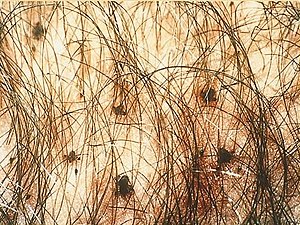Pediculosis pubis
| Pediculosis pubis | |
|---|---|
 |
|
| Pubic lice in genital area | |
| Classification and external resources | |
| Specialty | infectious disease |
| ICD-10 | B85.3 |
| ICD-9-CM | 132.2 |
| DiseasesDB | 10028 |
| MedlinePlus | 000841 |
| eMedicine | med/1769 |
| MeSH | D010373 |
Pediculosis pubis (also known as "crabs" and "pubic lice") is a disease caused by the pubic louse, Pthirus pubis, a parasitic insect notorious for infesting human pubic hair. The species may also live on other areas with hair, including the eyelashes, causing pediculosis ciliaris. Infestation usually leads to intense itching in the pubic area. Treatment with topic agents such as permethrin or pyrethrin with piperonyl butoxide is exceedingly effective. Worldwide, pediculosis pubis affects about 2% of the population.
Infestation with pubic lice is also called phthiriasis or phthiriasis pubis, while infestation of eyelashes with pubic lice is called phthiriasis palpebrarum or pediculosis ciliarum. The disease is spelled with phth, even though the scientific name of the louse is spelled with pth.
The main symptom is itching, usually in the pubic-hair area, resulting from hypersensitivity to louse saliva, which can become stronger over two or more weeks following initial infestation. In some infestations, a characteristic grey-blue or slate coloration macule appears (maculae caeruleae) at the feeding site, which may last for days. Nits or live lice may also be visible to the unaided eye.
Pubic lice are between 1 and 3 mm long with 6 legs.
Pubic lice are usually acquired by intimate contact between individuals. Parent-to-child infestations are more likely to occur through routes of shared towels, clothing, beds or closets. Adults are more frequently infested than children. As with most sexually transmitted pathogens, they can only survive a short time away from the warmth and humidity of the human body.
Infection in a young child or teenager is not necessarily indicative of sexual abuse, although this possibility should be kept in mind.
A pubic louse infestation is usually diagnosed by carefully examining pubic hair for nits, nymphs, and adult lice. Lice and nits can be removed either with forceps or by cutting the infested hair with scissors (with the exception of an infestation of the eye area). A magnifying glass or a stereo-microscope can be used for the exact identification. If lice are detected in one family member, the entire family needs to be checked and only those who are infested with living lice should be treated.
...
Wikipedia
